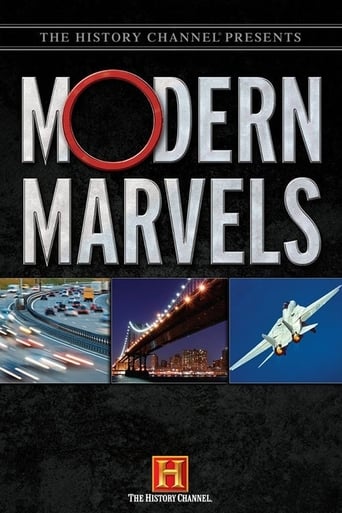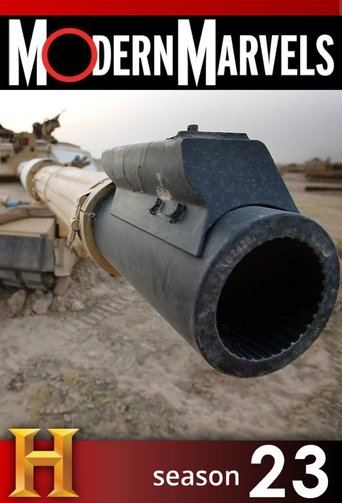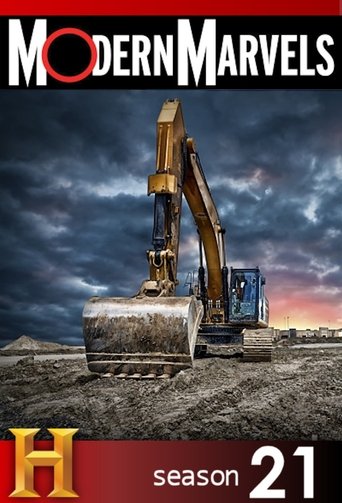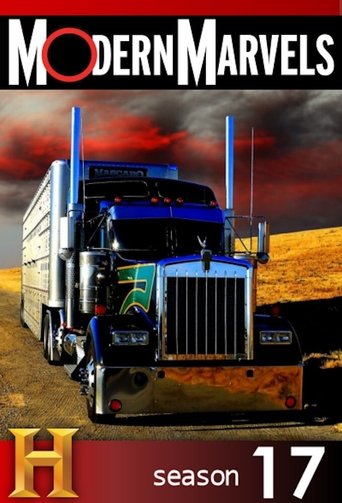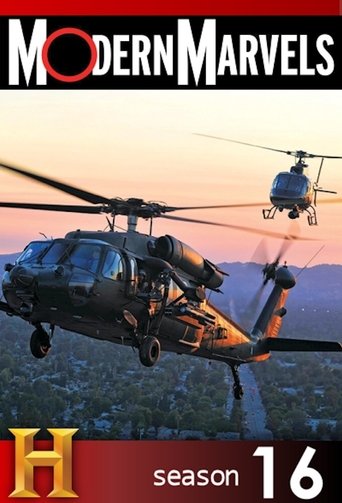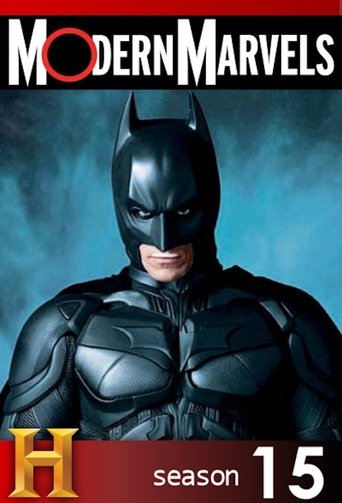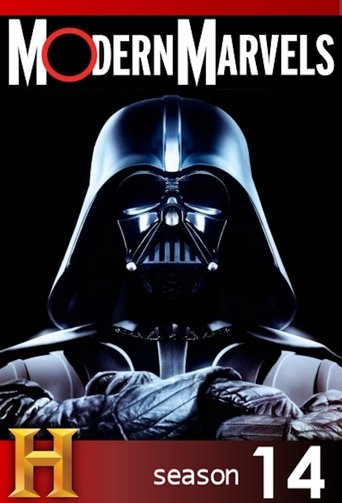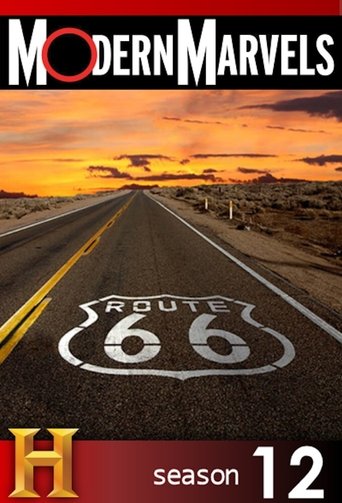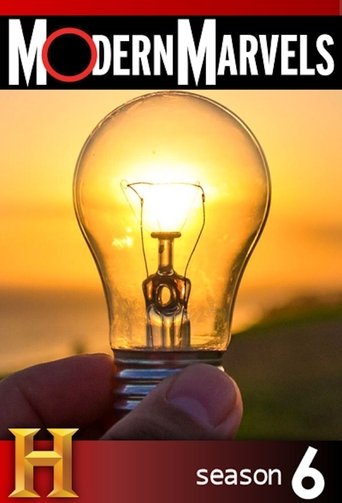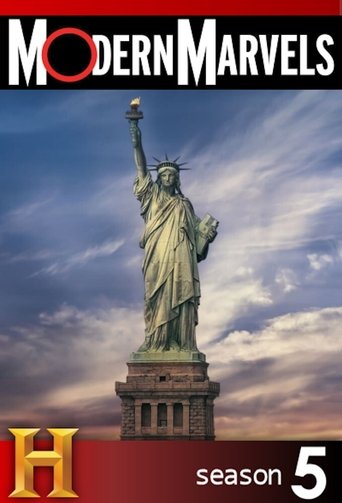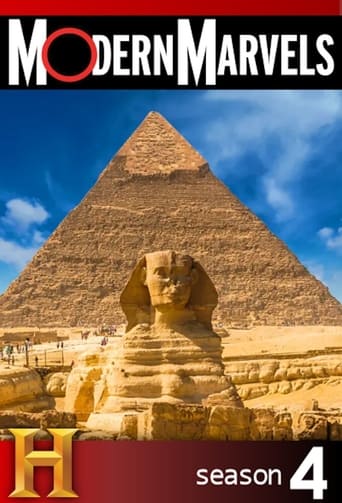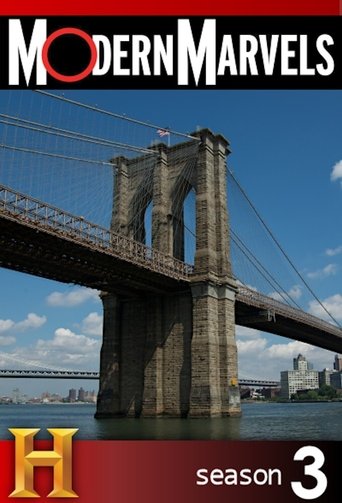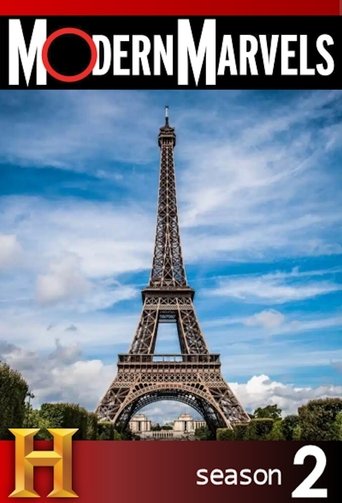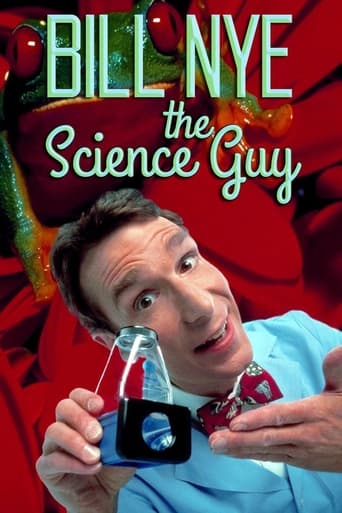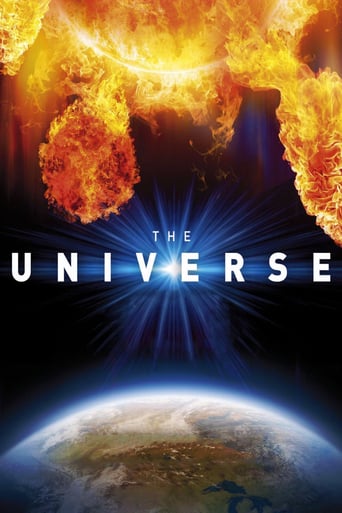Modern Marvels Season 7

HISTORY’s longest-running series moves to H2. Modern Marvels celebrates the ingenuity, invention and imagination found in the world around us. From commonplace items like ink and coffee to architectural masterpieces and engineering disasters, the hit series goes beyond the basics to provide insight and history into things we wonder about and that impact our lives. This series tells fascinating stories of the doers, the dreamers and sometime-schemers that create everyday items, technological breakthroughs and manmade wonders. The hit series goes deep to explore the leading edge of human inspiration and ambition.
Watch NowWith 30 Day Free Trial!
Modern Marvels
1993 / TV-PG


HISTORY’s longest-running series moves to H2. Modern Marvels celebrates the ingenuity, invention and imagination found in the world around us. From commonplace items like ink and coffee to architectural masterpieces and engineering disasters, the hit series goes beyond the basics to provide insight and history into things we wonder about and that impact our lives. This series tells fascinating stories of the doers, the dreamers and sometime-schemers that create everyday items, technological breakthroughs and manmade wonders. The hit series goes deep to explore the leading edge of human inspiration and ambition.
Watch Trailer
Modern Marvels Season 7 Full Episode Guide
Fortification evolved as man tried to defend his territory from attack. From fenced-in hills to walled cities to impenetrable forts, strongholds of the past echo the history of battles for territorial control. In a 2-hour special, we examine various historical defenses, including France’s Maginot Line, a defensive string of forts with enfilading firepower; the Atlantic Wall, 3,000 miles of shore fortifications built by Germany in WWII; and the North American Aerospace Defense Command (NORAD).
Join us as we take a peek at the plumbing hiding behind your walls and snaking under the floors of your house. We’ll also meet the plumbing students who undergo rigorous training programs in specialized classrooms designed to give them hands on installation experience. We’ll also check out the latest in plumbing technology from waterfall showers to water conserving toilets. This episode of Modern Marvels will examine the past, present and future of the arteries of our civilization; plumbing.
Arising from the horrible carnage, deprivation, and suffering caused by war is a countless array of everyday items–from hairbrushes to microwaves–that directly descend from wartime innovations. Wartime research and development have revolutionized communication, transportation, and medicine. From EM Spam /EM to nuclear power to hairspray and cell phones, life as we know it ironically owes a lot to war. We'll follow the day-to-day life of an ordinary woman and see the influence of war on her life.
Mankind controls the environment in a variety of ways, whether by capturing the force of a river, harnessing the power in coal or oil, controlling a nuclear reaction, or transforming the light of the sun into electricity. From Thomas Edison and Nikola Tesla to Enrico Fermi and Albert Einstein, the world's greatest minds have enabled us to acquire our light, heat, and power with a simple flip of the switch. Join us for an electrifying hour as we review the foundation for all of this–power plants.
Since the creation of the first laws, societies have demanded the ultimate punishment for certain capital crimes. Throughout history it has been left to a select few to develop the devices that will carry out the mandate of the people. This is the story of those inventors and their dark inventions. Modern Marvels traces the evolution of death technology up to the present and then take a brief look into its future.
Remotely operated vehicles allow us to explore the mysteries of inner and outer space, provide firsthand glimpses of the horrors of nuclear disasters, and offer the vicarious thrill of flying planes or driving cars. From the first remote controlled vehicle, Nikola Tesla’s 1898 steam-powered boat, to underwater ROVs that locate sunken vessels and explore the ocean floor, to their use by NASA in the space program, we see how ROVs extend our range into worlds previously unreachable, unknown, or unsafe.
Sign up at the ultimate survival school, where soldiers learn to kill or be killed, and learn how 21st-century warriors are training today for the battlefields of tomorrow. We follow combat training throughout history, reviewing survival skills and psychological tools–from ancient Rome to World Wars One and Two–and learn how modern training is enhanced by advanced technology and computer simulation
Deep beneath London runs a complex network of many miles of tunnels; and, while traffic congests the roads above, hundreds of trains run through these iron and concrete arteries, carrying millions of people into, around, and out of the City. Here is the story of the “Tube”, the world’s first underground railway, which holds London together–from its opening in January 1863, through its deep-level expansion and electrification, to the fully automated trains of the 21st Century’s Jubilee Line.
Since the ancient pharaohs’ time, the Isthmus of Suez has been the gateway to trade between East and West. It’s thought that the pharaohs could connect the Red Sea with the Mediterranean using a system of small canals; but the desert sands buried them. Not until mid-19th century did mankind readdress the problem. Since its completion in 1869, the Suez Canal has been a vital link in world trade and a point of controversy in geopolitics. Today, more than 20,000 ships transit the canal yearly.
According to the Encyclopedia Britannica, an assembly line is an “industrial arrangement of machines, equipment, and workers for continuous flow of workpieces in mass production operations.” While the basic principles of the assembly line technique have not changed in one hundred years, the people and the products that exploit the technique have. Throughout the hour, we will hear from four generations of assembly line workers who will provide some perspective, heart and soul for this revolutionary production technique.
The US agricultural process, from seed to shelf, is so efficient that most people don’t think much about it. But food growing and processing is ever more sophisticated, employing computer-guided, ground-shaking machinery, and sometimes controversial techniques. It’s an industry of declining family farms, diminishing returns, yet higher yields. We review the evolution of the tools used to produce food, show the steps in the cycle that bring food to the table, and look at the future of farming.
No one wants a hand-made car or gun or an airplane. We want things made by machines. Machine tools are power–driven machines–of all shapes and sizes-used to make metal parts. Machine tools built our modern world. Our life would not be possible without them. This show will take a look at these amazing machines in action. Beginning with the story of the steam engine and traveling to modern day “machining centers”–used to make incredibly complex space shuttle parts–we’ll look at the basic types of machine tools and their development. We’ll also look at some of the most modern machine tools of the future, including machines that are changing the way products of tomorrow are made.
Host Ron Hazelton and two mechanics dissect a 2000 Ford Taurus to trace the evolution of the automobile’s major systems. This 2-hour nuts-and-bolt special breaks the car down into its major components (engine, body, chassis, etc.). Starting with the earliest vehicles in the 1800s, automotive historians and experts describe how cars have evolved and explain major advances. And, finally concept cars and computer animations provide a glimpse into the future.
A fun-filled glimpse into the not so distant history of video games. Since inception, the gaming industry has been a driving force in computer technology and video games are one of today’s dominant entertainment mediums. We’ll talk to creators of many of the most popular games in an hour packed with thrilling visuals from the virtual world of video games.
The Maginot Line, a defensive string of large and small forts built during the years between World War I and World War II, was intended to forestall another invasion by aggressive Germany. Despite the Treaty of Versailles, France saw that it was only a matter of time before Germany would rise again and threaten France. News of northern neighbor Belgium’s neutrality left France with an exposed flank, which would ultimately be the Maginot Line’s weak point-the Germans were able to outflank the line almost entirely, readily conceding the Line’s impregnability while conquering the country.
When completed, China’s Three Gorges Dam will tower 607 feet in the air and weigh 40 Great Pyramids. Other than China’s Great Wall, it will be the only man-made object visible from the moon. Supporters see it as key to a new China, controlling floods and bringing hydroelectric power to one of its least-developed areas. Critics voice a litany of concerns–from environmental to flooding the spectacular area for which it’s named. We trace its story–from ancient flood control to current controversy.
In 1954, Gamal Abdel Nasser, the Arab Republic of Egypt’s first prime minister, had a plan to bring his poor country into the 20th century. To pull it off, he needed to harness the flow of the world’s longest river–the Nile. The ambitious plan called for construction of a high dam in southern Egypt at Aswan. But the builders of the pyramids and the Suez Canal were no strangers to large undertakings. We’ll see how the Aswan High Dam socially, politically, culturally, and agriculturally affected Egypt.
Icons of the open road, trucks form the backbone of the construction and transportation industries. The facility to handle nearly any load and the ability to deliver goods almost anywhere make trucks integral to modern life. From 18th-century steam-powered carriages to tomorrow’s computerized trucks, it’s a long haul you’ll enjoy!
The Erie Canal was America’s first superhighway. It was a narrow ribbon of water carved through sheer rock and untamed wilderness. It featured an ingenious network of stone locks and aqueducts. Skeptics called it “Clinton’s Ditch,” but visionaries saw it as the gateway to a gleaming future. An engineering marvel when it was built some called it the Eighth Wonder of the World.
Backbones of worldwide economics, for centuries banks enabled the creation of wealth, and industry leaders became icons. But modern technology revolutionized the way banks do business, and the Internet insures they must adapt or disappear. From banking's early European origins to "e-banking", this is an hour you can't afford to miss!
Around the world and across the eons, gold stands as a symbol of power, wealth, and love. The quest for the yellow metal took men across oceans, into the depths of the Alaskan winter, and miles beneath South African earth. This is the story of the hunters of the precious metal and their methods for extracting it.
The most opulent are wheeled luxury liners with satellite TV and hot tubs–a far cry from the first bus, an 8-passenger carriage! Watch a bus being built from the ground up, and learn the differences in the standard types (transit, school, inter-city, and specialty). Pack your bags or lunch and travel down the road of bus history.
In less than a century, the world went from dirt tracks to highways, from propeller planes to space travel, from sailboats to supertankers. And in the process, we have created a glut of traffic on roadways, railways, airways, and seaways–traffic that must be controlled, managed, and regulated. We’ll see how it’s done.
Today, race cars tear up the tracks at 300 m.p.h. Computers and space-age composite materials are as much as part of racing as the drivers. They’re fast, they’re thrilling, and they’ve gone high-tech. We’ll review the history of the innovations that led to today’s technological wonders.
The plane’s on the runway and revving up for our flight of power and whimsy. The panorama reveals some amazing machines–from vintage aircraft to homemade winged wonders to posh private jets. It’s a tale that merges technological progress and the fantasies of an unique type of person, who refuses to be grounded by earth’s surly bonds.
As camping technology develops, it provides greater access to diverse outdoor environments. The earliest camping technology was developed out of necessity. Prehistoric man fashioned rudimentary backpacks and clothing out of bark and animal hide. The explorers and pioneers pushed the boundaries of the West in covered wagons, cooking over open fires, and living off the land. When men headed off to war, they returned with new camping gear and lightweight materials, which enabled further exploration. Today’s Himalayan mountaineers depend on carefully engineered clothing, tents, and boots to reach the highest peaks in the world.
Modern Marvels explores how the basic formula of cement, aggregate and water has changed the world. Concrete has enabled us to create everything from roads and runways to buildings and bridges. The program will explore the history as well as the future of this humble material?from the ancient Romans, who pioneered its use in their vast system of aqueducts, to modern engineers developing a bendable concrete more resistant to the destructive power of earthquakes.
An examination of the historical development of technological tools that help science mitigate nature’s fury. It’s a survival story that begins with comprehending the force of disaster. As environmental calamities unfold, viewers witness the urgency for change that each crisis compelled and innovations designed to lower death tolls.
When police forces were born in the 1800s, British “bobbies” made due with a billy club. Public wariness and institutional resistance to change held back technological advances for much of the 20th century. But in the last decades, police have been swept up in a technological revolution that has transformed nearly all aspects of crime fighting.
Don’t look now, but your office is a technological marvel. From the humble paper clip to the revolutionary personal computer, your desk is a museum of miracles designed to make you more productive and efficient. Then why are you still at work? Here’s everything you ever wanted to know about your workplace, but were afraid to ask!
Join us for a survey of the world’s greatest inventions in which we examine the wheel, steam engine, railroad, automobile, airplane, printing press, electric light, wireless telegraph, telephone, TV, and computer. Then, travel back in time to the labs, candle-lit offices, and garages to see how these marvels were created.
“All hope abandon, ye who enter here!” This sentiment has permeated the masonry and clanging bars of prisons built throughout the ages. We’ll see how the philosophy and architecture of today’s American prisons emerged from the sewer cells and castles and dungeons of ancient Rome, medieval Europe, and 18th-century England.
From amazing ancient Roman aqueducts and arch bridges, romantic Renaissance spans, 19th-century railroad crossovers, to monumental marvels of our time, bridges played a key role in the human quest to connect and unify. We'll trace the history of bridge types, including suspension, arch, beam, truss, and cantilever designs.
The pentagon…The name alone conjures up an imposing image of American power and prestige. As the largest office building in the world, it serves as the headquarters of the nation’s armed forces. Every day, more than 24,000 men and women come here to work on the vital and sometimes top secret business of national defense. Beyond the pentagon’s massive size and awesome purpose looms its impenetrable mystique. We’ll take you inside this military institution, national symbol, and modern marvel.
Join us on an out-of-this-world exploration of the history of long-duration life in space–from the first Soviet station to Skylab to Mir to the International Space Station. Experience what it is like to live in space, as well as the monumental obstacles engineers and astronauts overcame to make it possible.
The challenge of linking Britain and France with a tunnel under the English Channel was both monumental and delicate. It took 18 months just to design and build the 28 foot diameter TBMs, and nearly a year to assemble and position them underground. Modern Marvels takes you through the entire process from start to finish.
Join us as we span the history of one of the world’s most famous bridges, London’s Tower Bridge. The world’s largest bascule bridge (a counterweighted drawbridge), when it was erected in 1892, it became a postcard image of London. The famed gothic towers of this pioneering steel structure, sheathed in stone, are purely decorative.
Beneath every modern city, hidden by manhole covers, drains, and ventilation grates – lies a labyrinth of tunnels, wires, conduits and pipes. They deliver power to our homes, water to our faucets, messages to our loved ones and sometimes – they even move us. Workers create the secret world beneath our feet using everything from shovels, pickaxes and dynamite to multi-million dollar tunneling equipment. The modern subterranean worker, or as they like to be called, “Sandhogs” use time tested methods as well as modern inventions, such as airlocks and computerized mapping techniques to avoid pitfalls and get the job done in the city beneath the street.
Free Trial Channels
Seasons


